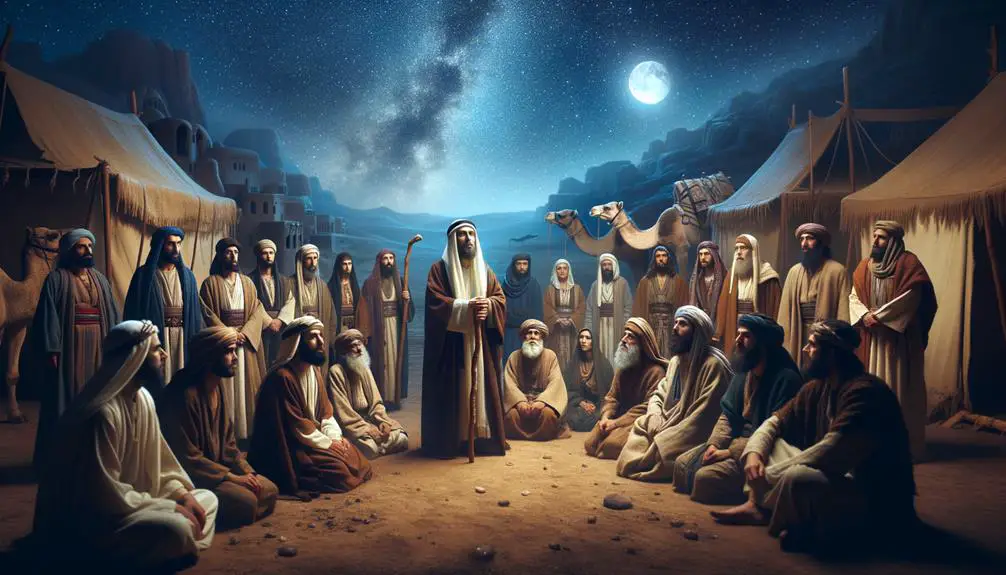Find out the mysterious origins of the Kenites' patriarch in the Bible and why this lineage continues to intrigue scholars and believers alike.

Who Was the Father of the Kenites in the Bible
Isn't it curious how sometimes you stumble upon mysteries in the most ancient texts? You've probably pondered over the enigmatic Kenites, a group mentioned in the Bible whose origins and lineage spark intrigue.
The question of who fathered this nomadic clan is shrouded in biblical anecdotes and genealogical breadcrumbs. Unveiling the patriarch of the Kenites isn't just a matter of tracing names; it's about understanding their pivotal role in biblical narratives and how they've influenced historical interpretations.
You're on the brink of uncovering a story that weaves through time, offering insights into the complex tapestry of biblical history. Why did this lineage matter, and what can it tell us about the broader biblical context? Stick around, and let's unravel this together.
Key Takeaways
- The father of the Kenites in the Bible is Jethro, a Midianite priest and Moses' father-in-law.
- Jethro's wisdom and spiritual leadership significantly shaped the Kenite community.
- Biblical references associate the Kenites as descendants of Hobab, further linking them to Jethro.
- The Kenites' positive portrayal in the Bible underscores their friendly relations and integration with the Israelites.
Unraveling the Kenite Legacy

To understand the Kenites' significant impact on biblical history, it's essential to explore their origins and the role of their patriarch. The Kenites, known as desert dwellers, were a nomadic group described in the Hebrew Bible. Their movements, or Kenite migrations, are crucial to comprehending their unique position in ancient Near Eastern history. These migrations weren't aimless wanderings but strategic relocations that allowed them to thrive in arid environments and interact with various ancient civilizations.
Analyzing the Kenite legacy requires a look into their lifestyle as desert dwellers. Their existence in such harsh conditions wasn't merely a struggle for survival; it was a testament to their resilience and adaptability. This lifestyle influenced their social structures, religious beliefs, and interactions with neighboring tribes and kingdoms. The Kenites' expertise in metalworking, possibly a skill honed in the desert's demanding environment, set them apart and facilitated their relationships with other groups.
Their migrations played a pivotal role in shaping the region's geopolitical landscape. As the Kenites moved, they forged alliances and exchanged cultural and technological knowledge, impacting the development of the societies they interacted with. This nomadic tribe's legacy is intertwined with the broader narrative of the ancient Near East, highlighting the significance of understanding their journey and contributions.
The Patriarch Revealed
While delving into the Kenites' desert legacy, it's crucial to identify Jethro, also known as Reuel, as their esteemed patriarch, whose influence permeates their storied history. Understanding the Kenite origins requires a closer look at Jethro, not only because of his familial ties but also due to his significant role in shaping the spiritual and social fabric of the Kenites. His position as a Midianite priest underscores the intertwining of religious leadership and patriarchal lineage within this nomadic tribe.
Jethro's legacy is pivotal in tracing the Kenite lineage, offering insights into the complexities of their identity. As the father-in-law of Moses, Jethro's connection to the Israelites introduces a fascinating layer to the Kenite narrative, blending familial alliances with spiritual mentorship. This relationship further highlights the symbiotic ties between the Kenites and other Semitic tribes, emphasizing the importance of kinship and alliance in ancient Near Eastern societies.
The examination of Jethro as the Kenite patriarch isn't merely about establishing a genealogical link; it's about appreciating the depth of his impact on the Kenite community. His wisdom and leadership not only guided his immediate family but also left an indelible mark on the broader Kenite identity. Through Jethro, one can glimpse the intricacies of Kenite origins and their patriarchal lineage, which is essential for grasping the broader narrative of their place within the tapestry of biblical history.
In essence, unraveling Jethro's role offers a foundational understanding of the Kenite lineage, enriching our comprehension of their unique position in the ancient world.
Biblical References and Clues

Exploring the biblical references and clues unveils the intricate connection between Jethro, the Kenites, and the broader narrative of the ancient Near East. You'll find that scripture doesn't explicitly name a single patriarch for the Kenites. However, it does provide enough context to engage in informed speculation and analysis. The mention of Jethro, Moses' father-in-law, as a priest of Midian and his association with the Kenites, sparks a significant part of these discussions.
The genealogical debates surrounding the Kenites are fueled by various biblical passages that hint at their lineage and relationships with neighboring tribes. For instance, Judges 1:16 and 4:11 refer to the Kenites as descendants of Hobab, Moses' brother-in-law. This connection suggests a familial link that has been a focal point for scholars attempting to trace the Kenite migrations and their eventual settlements within Canaan.
These migrations aren't just a minor detail; they're crucial for understanding the Kenites' integration into the socio-political fabric of the region. The Bible, while not a historical document in the modern sense, provides valuable insights into these movements. It portrays the Kenites in a largely positive light, highlighting their friendly relations with the Israelites and their role in the stories of Deborah and Barak.
Kenites in Historical Context
Understanding the biblical references provides a foundation, but situating the Kenites within the historical context of the ancient Near East reveals the depth of their impact on regional dynamics. The Kenite migrations are key to comprehending their role and relationships with neighboring peoples. These movements weren't merely random or survival-driven wanderings but were strategic, influencing trade routes, military alliances, and cultural exchanges.
You'll find that the Kenites' nomadic lifestyle facilitated their cultural adaptations, allowing them to integrate and influence the societies they interacted with. Their skills in metalworking, particularly in iron and bronze, didn't just earn them a reputation but also a pivotal role in the technological advancement of the regions they settled in or passed through. This expertise likely contributed to their economic importance and the formation of symbiotic relationships with other groups.
Moreover, the Kenites' ability to adapt culturally while maintaining a distinct identity allowed them to serve as mediators and cultural brokers in the ancient Near East. Their interactions ranged from peaceful coexistence to becoming integral members of larger societies, such as the Israelites, with whom they had a notably close relationship according to biblical narratives.
Theological Significance

You'll find the theological significance of the Kenites' patriarch in the Bible reveals much about symbolic interpretations and covenantal relationships. These aspects underscore the nuanced ways in which ancient narratives shape spiritual understanding and community bonds.
Analyzing these elements helps you grasp the broader theological implications that ripple through religious texts and traditions.
Symbolic Interpretations
Throughout the Biblical narrative, the Kenites' father symbolizes a bridge between ancient nomadic lifestyles and settled agricultural communities, reflecting a nuanced understanding of societal evolution and spiritual identity. This figure, often shrouded in mystery, serves as a pivotal point for exploring Kenite metaphors and their allegorical roles within the scriptures.
The Kenites, through their patriarch, embody a complex interplay of tradition and transition, marking a significant thematic element in the Biblical text. Their story isn't just historical; it's steeped in layers of meaning that speak to the adaptability and resilience of faith communities.
Covenantal Relationships
In the Biblical narrative, the Kenites' covenantal relationships underscore a profound theological significance, revealing how divine agreements shaped their spiritual and communal identity. These covenants, often intertwined with marriage dynamics, weren't merely agreements but were foundational in establishing the Kenites within the larger biblical story. The consequences of these alliances were multifaceted:
- Spiritual Integration: Through marriages, the Kenites were woven into the fabric of Israelite society, highlighting the inclusivity of divine promises.
- Political Stability: Alliances brought peace and mutual protection, showcasing the practical benefits of covenantal relationships.
- Cultural Exchange: These unions facilitated a two-way flow of traditions and beliefs, enriching both the Kenites' and Israelites' understanding of faith.
Analyzing these aspects reveals the complexity and significance of covenantal relationships within the biblical context, especially in terms of marriage dynamics and alliance consequences.
Implications for Biblical History
Understanding the role of the father of the Kenites has profound implications for the broader narrative of biblical history, shedding light on the complex interplay of tribal relations and their influence on the unfolding biblical events. Archaeological evidence suggests that the Kenites, a nomadic group, played a significant role in the cultural diffusion that characterized the ancient Near East. This not only broadens your understanding of the Kenites' place within the biblical narrative but also offers insights into how tribes and cultures interacted and influenced each other during this period.
The Kenites' integration into Israelite society, as depicted in the Bible, underscores a broader theme of assimilation and alliance among distinct groups within the biblical world. This phenomenon had lasting effects on the development of Israelite culture, religion, and social structure. By examining the father of the Kenites, you're not just uncovering the story of one tribe; you're unpacking the dynamics that shaped the entire region's history.
Furthermore, the Kenites' expertise in metalwork, as described in the biblical texts, highlights the importance of technological exchange in shaping societal roles and economic development. This aspect of the Kenites' contribution to the Israelite community offers a tangible example of how technological advancements can influence cultural and historical trajectories.
Frequently Asked Questions
How Did the Kenite's Relationship With the Israelites Influence the Latter's Religious Practices and Beliefs?
Your exploration into how the Kenite's relationship with the Israelites impacted their religious practices reveals a case of religious syncretism. The Kenite migration brought them into close contact with the Israelites, blending their beliefs and practices.
This blending wasn't just superficial; it seeped into the fabric of Israelite religious identity, subtly shaping rituals and introducing new deities into their pantheon, illustrating a complex interplay of cultural and spiritual exchange.
Were There Any Specific Marriage Alliances Between the Kenites and Prominent Israelite Families That Impacted Biblical Narratives?
Yes, specific marriage alliances between the Kenites and Israelite families indeed shaped biblical narratives, like threads weaving through a tapestry. These unions weren't just personal bonds but strategic links that influenced trade routes and desert nomadism, highlighting the Kenites' integral role in the region's socio-economic fabric.
Analyzing these connections offers a detailed, objective look into how such alliances impacted religious and cultural exchanges, deeply embedding the Kenites within the biblical story.
Are There Any Modern Descendants of the Kenites, and How Do They Identify Themselves Today?
You're curious about the modern descendants of the Kenites and their self-identification today. Genetic research and cultural assimilation complicate this inquiry.
While genetic studies might trace lineage back to ancient populations, cultural assimilation over millennia makes it challenging to find distinct communities identifying as Kenites in the modern era.
Most descendants have likely blended into broader populations, losing specific Kenite identity due to these factors.
How Have Interpretations of the Kenites' Role in the Bible Changed With New Archaeological Discoveries?
As new archaeological discoveries emerge, your understanding of the Kenites' biblical role evolves. These findings, highlighting Kenite metallurgy and their nomadic integration, offer a deeper insight.
Previously, interpretations might've leaned on textual analysis alone, but now, evidence of their metalwork and interactions with neighboring tribes paints a richer picture.
This shift isn't just academic; it reshapes how you view their historical and cultural significance in a broader ancient context.
In What Ways Have the Kenites Been Represented or Mentioned in Non-Biblical Historical Records From Neighboring Civilizations?
Diving into history's tapestry, you'll find the Kenites woven into non-biblical records with threads of Kenite metallurgy and nomadic integration. These records, from neighboring civilizations, spotlight their expertise in metalwork and their seamless blending into various societies.
Analytically speaking, these mentions not only underscore their craftsmanship but also highlight their adaptability and influence across borders, offering a richer, more detailed picture of their role beyond the biblical narrative.
Conclusion
In conclusion, the Kenite legacy, deeply rooted in biblical history, centers around Jethro, Moses' father-in-law, as their patriarch. Through an analytical dive into scriptures and historical contexts, you've seen how their story intertwines with Israel's narrative, offering a unique theological perspective.
Consider the case of Moses' Midianite connections; it's more than a mere familial tie—it symbolizes the Kenites' integration and influence within Israel. This exploration not only enriches our understanding of biblical history but also highlights the intricate relationships that shaped the ancient world.



Sign up